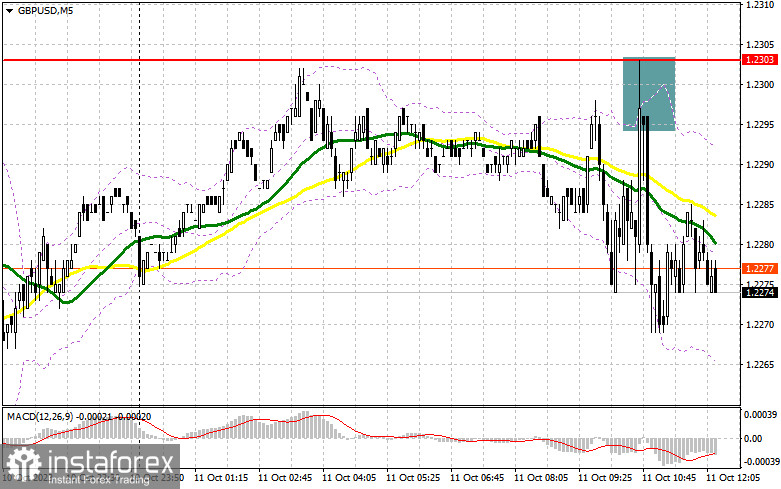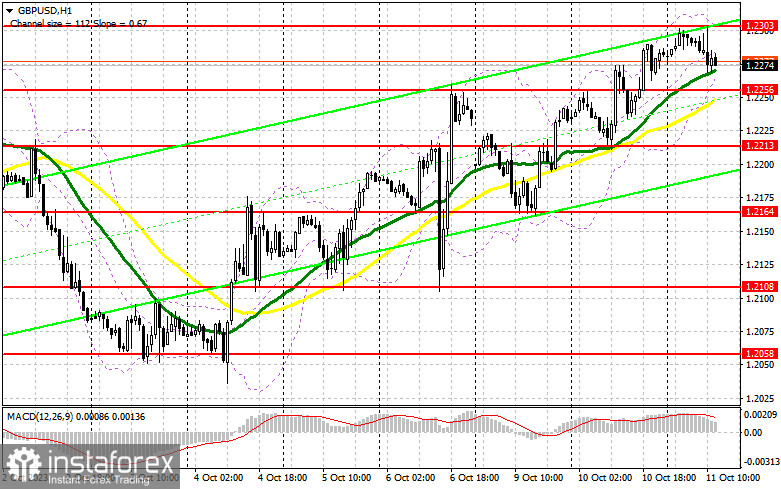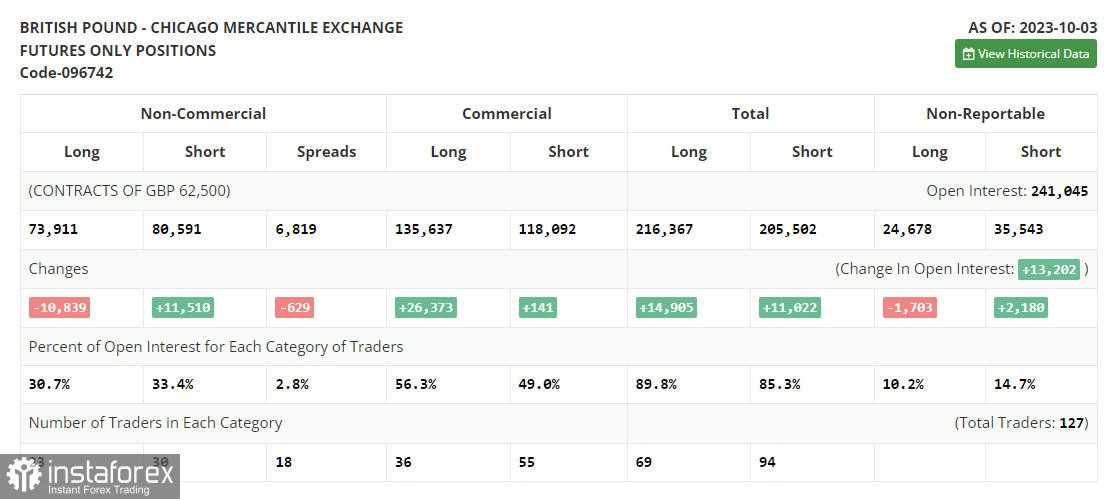In my morning forecast, I emphasized the 1.2303 level and recommended making trading decisions based on it. Let's take a look at the 5-minute chart and analyze what happened. The rise and the formation of a false breakout at 1.2303 provided a good entry point for opening short positions, resulting in a drop of more than 30 points for the pair. In the second half of the day, the technical picture remained unchanged.

To open long positions on GBP/USD, the following conditions are required:
Considering that US inflation data may boost demand for the dollar, the pressure on GBP/USD is likely to persist until the release of the September FOMC meeting minutes and the speeches by FOMC members Michelle Bowman and Raphael Bostic. For this reason, I prefer to act after a decline and the formation of a false breakout around the nearest support at 1.2256, which will signal a buy opportunity aiming for a move towards the weekly high around 1.2303, where bears have shown resistance once today, so another test could prove successful. Breaking and holding above this range will allow buyers to establish a new bullish trend, giving a chance for a retest of 1.2342. The ultimate target will be the 1.2380 area, where I will take profits. In the scenario of a drop to 1.2256 and the absence of activity in the second half of the day, which seems to be the case, trading will likely move into a sideways range, which may not bode well for pound buyers. This will also open the path to 1.2213. A false breakout there, similar to what I discussed earlier, will signal the opening of long positions. I plan to buy GBP/USD only on a bounce from the 1.2164 minimum, with the target of a 30-35 point correction within the day.
To open short positions on GBP/USD, the following conditions are required:
The bears need to continue defending the nearest resistance at 1.2303. Only a false breakout at this level, similar to what I discussed earlier, as well as data related to another surge in US producer prices, will give a signal to sell, potentially pushing the pair down to 1.2256, where the moving averages are in favor of the bulls. Breaking and retesting this range from below will deal a more significant blow to the positions of buyers, opening the way to 1.2213. The ultimate target will be 1.2164, where I will take profits. In the case of GBP/USD's rise and the absence of activity at 1.2303 in the second half of the day, which cannot be ruled out due to a sudden change in the tone of Federal Reserve representatives towards a more dovish stance, demand for the pair will only increase, giving buyers a chance for a continued upward correction. In this case, I will postpone selling until a false breakout at 1.2342. If there is no downward movement at that point, I will sell the pound immediately on a bounce from 1.2380, but only with the expectation of a 30-35 point correction within the day.


Indicator Signals:
Moving Averages
Trading is taking place above the 30 and 50-day moving averages, indicating the continuation of the pair's growth.
Note: The period and prices of the moving averages discussed by the author are considered on the hourly H1 chart and differ from the general definition of classical daily moving averages on the daily D1 chart.
Bollinger Bands
In the case of a decline, the lower boundary of the indicator at around 1.2270 will act as support.
Description of indicators:
Moving average (determines the current trend by smoothing volatility and noise). Period 50. Marked in yellow on the chart.Moving average (determines the current trend by smoothing volatility and noise). Period 30. Marked in green on the chart.MACD indicator (Moving Average Convergence/Divergence - convergence/divergence of moving averages). Fast EMA period 12. Slow EMA period 26. SMA period 9.Bollinger Bands. Period 20.Non-commercial traders - speculators, such as individual traders, hedge funds, and large institutions using the futures market for speculative purposes and meeting certain requirements.Long non-commercial positions represent the total long open positions of non-commercial traders.Short non-commercial positions represent the total short open positions of non-commercial traders.The net non-commercial position is the difference between the short and long positions of non-commercial traders. English
English 
 Русский
Русский Bahasa Indonesia
Bahasa Indonesia Bahasa Malay
Bahasa Malay ไทย
ไทย Español
Español Deutsch
Deutsch Български
Български Français
Français Tiếng Việt
Tiếng Việt 中文
中文 বাংলা
বাংলা हिन्दी
हिन्दी Čeština
Čeština Українська
Українська Română
Română

